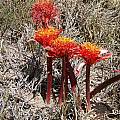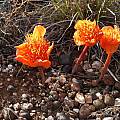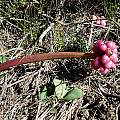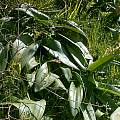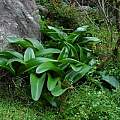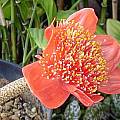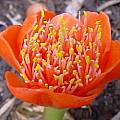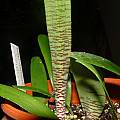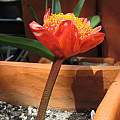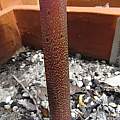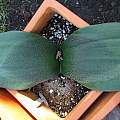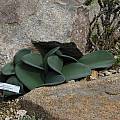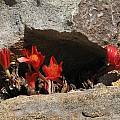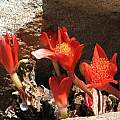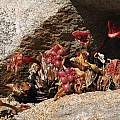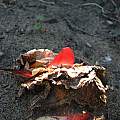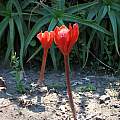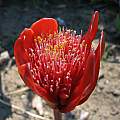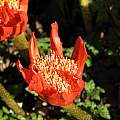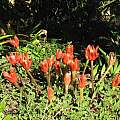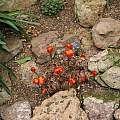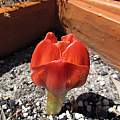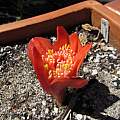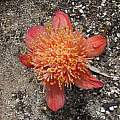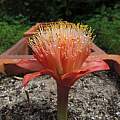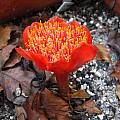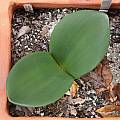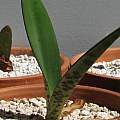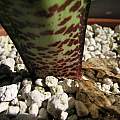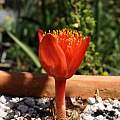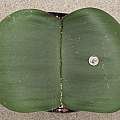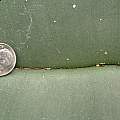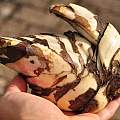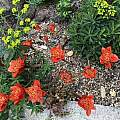Haemanthus coccineus L. is found on coastal scrub and rocky slopes in a wide distribution, from the western edge of the Eastern Cape (transitional rainfall patterns), westwards through the winter rainfall region of the Western Cape and up to the arid regions of Namaqualand and Namibia. This is an enormous range of 2000+ kilometers and climate variation! Because of that, there are many forms of the species. The flower stems can be reddish, or blotched with red and the leaves have varying degrees of stripes and dots on the underside. Plants vary in height to about 40 cm. The species flowers in autumn before the leaves appear and the flowers are very similar to Haemanthus sanguineus although the leaves are generally not adpressed. This species is one of the most commonly cultivated species of the genus. It requires a well drained medium, full sun, good water during the growing season, and a dry summer rest.
Photos 1-4 were taken by Cameron McMaster showing the flowers, the fruit, and leaves photographed in the Overberg. Photo 5 of the leaves was taken by Mary Sue Ittner near Bainskloof September 2006. Photo 6 from Alan Horstmann shows the seeds.
Photo 1 is of a plant grown and photographed by Doug Westfall. This view shows the beautifully marked stem of this clone. This one blooms faithfully every year. It marked underside leaves in some forms. Note that these seedlings show tiny hairs too, a trait lost on adult plants. Photos 4-6 were taken by Nhu Nguyen. Photo 5 shows produces a large number of seeds every second year. Photo 2 is from Lyn Edwards. Photo 3 by Angelo Porcelli shows a hidden feature of this species, the nicely beautiful spotted markings on the peduncle of this form. Photo 6 shows a different form with giant leaves. Note that there are ice crystals on the leaves. This was due to light frost (-2 °C for about 6 hours) and once the ice melted away, the leaves returns to normal.
The photos below were taken by Nhu Nguyen at the UC Botanical Garden showing various aspect of this beautiful form with glaucous blue leaves.
The photos below were taken by Nhu Nguyen. Photos 1-5 were taken at the Strybing Arboretum/San Francisco Botanical Garden. Photo 4 was taken at the Royal Botanic Garden, Edinburgh.
Photos below by Nhu Nguyen and Uluwehi Knecht show a form from Lüderitz, Namibia. The leaves are a very bright green, uprightly arching, thick, and shiny with a recurving leaf margin. No markings are present on the leaf undersides. The leaves in the picture were photographed at only under half of the length they grow to each winter. Photos 3-4 show the inflorescence that developed in shady conditions.
The photos below by Nhu Nguyen show the leaves, the typical spotting found in this species, and the inflorescence.
Photos below show a form with particularly wide leaves from Cape Agulhas with a U.S. ten cent piece for scale (2 cm), grown by Uluwehi Knecht. The leaves look like H. sanguineus but the bulb shape belongs to the coccineus group.
The first photo of the bulb by Pontus Wallstén. The second photo from Wayne Carter of flowering in his New Zealand garden in March 2021.
Photos of Haemanthus coccineus in habitat by Rob Skillin. The first photo is of a plant growing near the beach at Hondeklip Bay, Namaqualand. The second shows the huge population the plant is from, all growing in a thick bed of broken shells washed up on the beach, on a hazy afternoon. The third is of the fruits of a plant from a hillside a few kilometers west of Vanrhynsdorp, Western Cape Provence, in early May.
